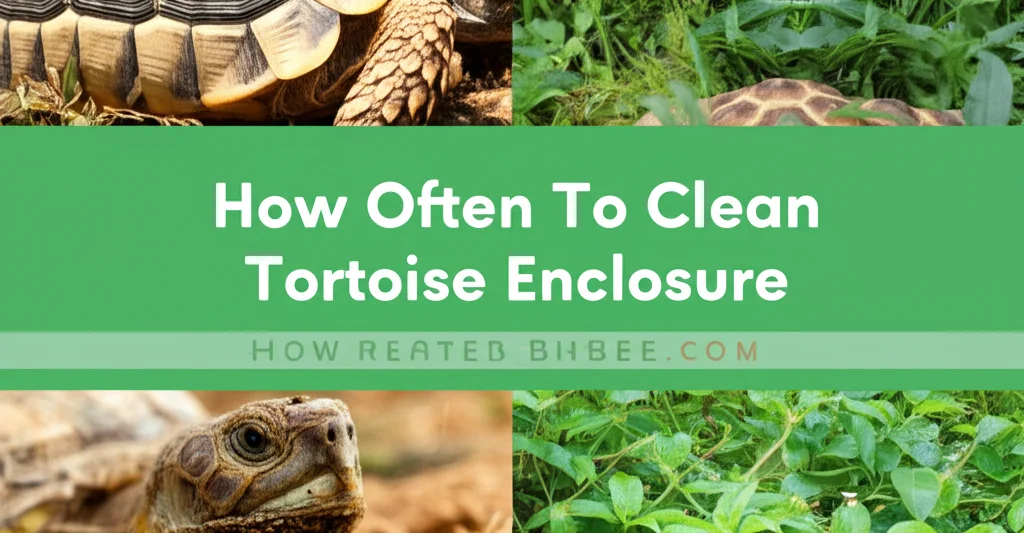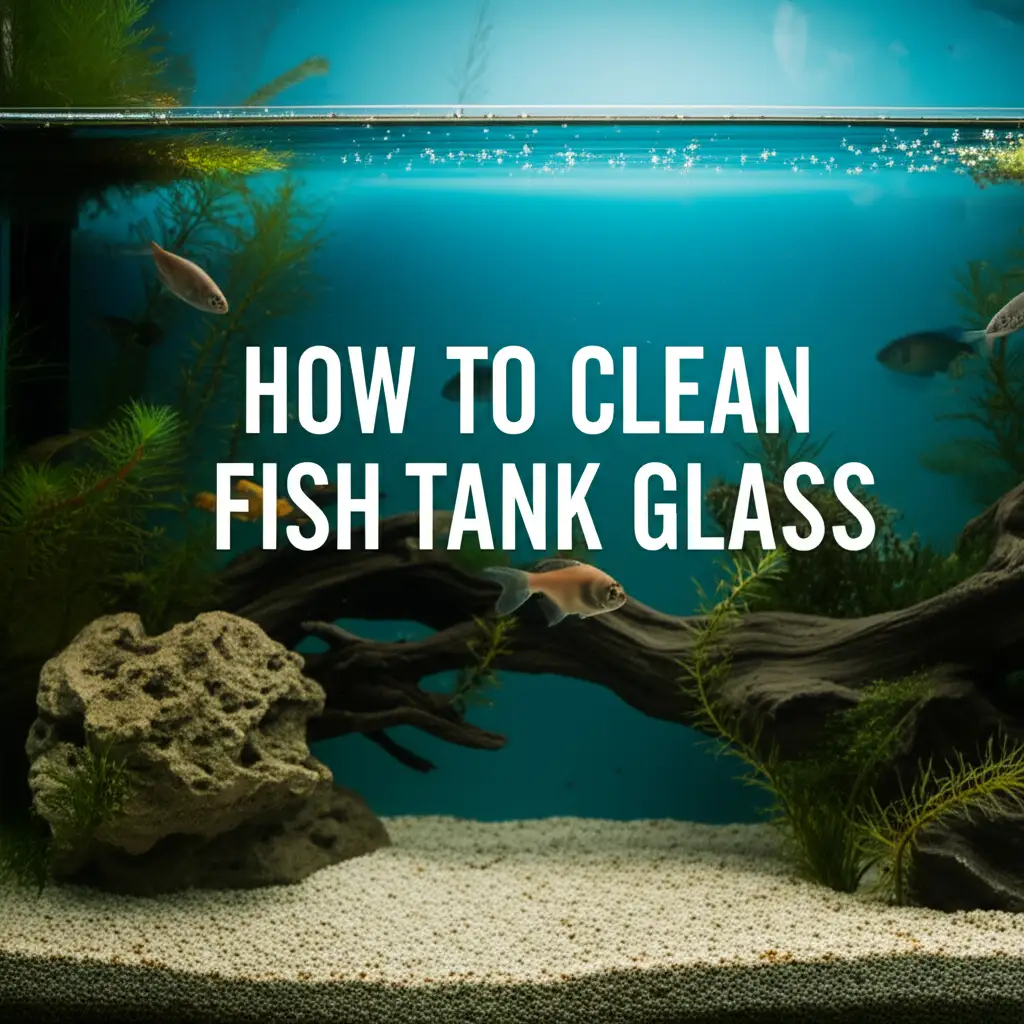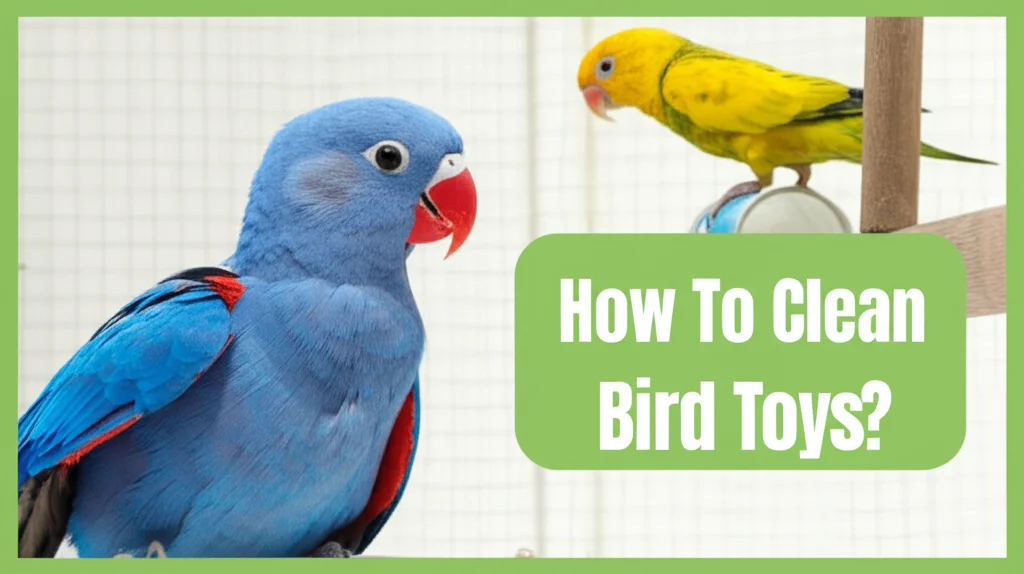· Pet Care · 20 min read
How Often To Clean Tortoise Enclosure

How Often to Clean a Tortoise Enclosure: The Complete Care Guide
Introduction
Maintaining a clean habitat is one of the most crucial aspects of tortoise ownership that directly impacts your pet’s health and wellbeing. Whether you’re a first-time owner or an experienced tortoise enthusiast, understanding how often to clean a tortoise enclosure can be surprisingly complex due to the various factors involved. Different tortoise species have specific environmental needs, and cleaning too frequently or not often enough can both create problems for your shelled companion.
In this comprehensive guide, we’ll explore the ideal cleaning schedules for tortoise habitats, dive into effective cleaning methods, and share expert tips for maintaining optimal hygiene while ensuring your tortoise remains stress-free and healthy.
From daily spot cleaning to complete substrate changes, we’ll cover everything you need to know about keeping your tortoise’s home in pristine condition.
Key Takeaways:
- Spot clean tortoise enclosures daily to remove waste and uneaten food
- Perform partial substrate changes weekly for proper hygiene
- Complete a deep clean with full substrate replacement every 1-3 months
- Adjust cleaning frequency based on enclosure size, tortoise species, and substrate type
- Balance cleanliness with maintaining beneficial microorganisms in the habitat
In short: Most tortoise enclosures require daily spot cleaning, weekly partial substrate changes, and monthly deep cleaning with complete substrate replacement to maintain proper hygiene and prevent disease while minimizing stress to your pet.
Understanding Tortoise Enclosure Basics
Before diving into cleaning schedules, it’s important to understand what constitutes an ideal tortoise habitat. Tortoises thrive in environments that closely mimic their natural habitats, which vary significantly depending on the species. Desert species like Russian tortoises require dry conditions with low humidity, while tropical species such as Red-footed tortoises need higher humidity levels and different substrates.
A proper tortoise enclosure typically includes:
- Appropriate substrate (coconut coir, cypress mulch, or topsoil mixtures)
- Hiding spots and shelters
- Water dish (large enough for soaking)
- Feeding area
- Heat and UVB lighting
- Temperature gradient and basking spot
- Humidity controls (for tropical species)
The size and type of enclosure—whether indoor or outdoor, glass terrarium or wooden table—will influence your cleaning routine. Larger enclosures may require less frequent deep cleaning than smaller ones, as waste is distributed over a greater area. Similarly, the number of tortoises sharing an enclosure directly impacts how quickly the habitat becomes soiled.
Understanding these basics helps establish a foundation for developing an appropriate cleaning schedule tailored to your specific tortoise and setup. Proper enclosure design can also make cleaning easier and more efficient, which we’ll discuss in later sections.
Daily Cleaning Tasks for Tortoise Enclosures
Daily maintenance is essential for keeping your tortoise’s environment clean and healthy. These quick tasks take just a few minutes but make a significant difference in overall habitat hygiene and can prevent more serious issues from developing.
Spot Cleaning
Spot cleaning is the cornerstone of daily tortoise enclosure maintenance. This involves:
- Removing all feces and urine spots as soon as you notice them
- Disposing of uneaten food (especially fresh vegetables and fruits)
- Checking for and removing any moldy or rotting substrate
For efficient spot cleaning, use a small handheld scoop or reptile-safe tongs to remove waste and a paper towel to absorb any moisture from urine spots. Be thorough but gentle to avoid disturbing your tortoise unnecessarily.
Water Dish Maintenance
Clean water is crucial for tortoise health. Daily water maintenance should include:
- Emptying and rinsing the water dish
- Scrubbing with a brush if algae or slime is present
- Refilling with fresh, clean water
- Checking for and removing any substrate that may have been tracked into the dish
Many tortoises defecate while soaking, making daily water changes even more important. If you notice your tortoise has soiled its water dish, clean it immediately rather than waiting for your next scheduled maintenance.
These daily tasks prevent ammonia buildup from waste, reduce bacterial growth, and create a more pleasant environment for both your tortoise and you. Consistency with daily cleaning significantly reduces the frequency of deep cleaning needed and helps prevent common health issues like shell rot and respiratory infections.
Weekly Cleaning Routine
While daily spot cleaning addresses immediate concerns, a more thorough weekly cleaning is necessary to maintain optimal hygiene in your tortoise’s habitat. Weekly cleaning helps prevent the buildup of harmful bacteria and parasites that aren’t visible to the naked eye.
Partial Substrate Change
A partial substrate change involves:
- Removing approximately 25-30% of the existing substrate
- Focusing on areas where your tortoise frequently eliminates waste
- Replacing with fresh, clean substrate of the same type
- Mixing the new substrate with the remaining older material
This approach maintains beneficial microorganisms while removing potentially harmful waste products. Think of it as similar to changing the water in a fish tank rather than completely emptying it each time.
Cleaning Décor and Accessories
Weekly cleaning should also include:
- Wiping down hiding spots, ramps, and other fixtures
- Cleaning food dishes thoroughly with hot, soapy water
- Sanitizing water dishes with a tortoise-safe disinfectant
- Checking and cleaning any artificial plants or decorations
When cleaning accessories, use mild dish soap and rinse thoroughly to ensure no soap residue remains. For disinfecting, you can use a reptile-safe disinfectant or a diluted vinegar solution (1 part vinegar to 3 parts water).
Habitat Check-Up
The weekly cleaning provides an excellent opportunity to:
- Inspect heating elements and UVB lights for proper functioning
- Check temperature and humidity levels
- Examine the enclosure for any damage or areas needing repair
- Assess your tortoise’s overall health and behavior
Regular weekly cleaning prevents the buildup of pathogens while allowing your tortoise to maintain familiarity with its environment. This balance is crucial for reducing stress while ensuring proper hygiene.
For indoor enclosures that use bioactive setups with cleanup crews (like isopods), you might be able to extend the interval between partial substrate changes, as these beneficial organisms help break down waste naturally. However, monitoring is still essential to ensure the system is functioning properly.
Monthly Deep Cleaning Protocol
A thorough deep cleaning of your tortoise’s enclosure should be performed every 1-3 months, depending on enclosure size, the number of tortoises, and how quickly the habitat becomes soiled. This comprehensive cleaning helps eliminate any buildup of bacteria, fungi, and parasites that regular maintenance might miss.
Complete Substrate Replacement
During a deep clean, you’ll want to:
- Remove your tortoise to a temporary holding enclosure
- Take out all décor, dishes, and accessories
- Completely remove all substrate
- Clean the bare enclosure thoroughly
- Add fresh, new substrate
- Replace cleaned décor and accessories
The frequency of complete substrate changes varies based on several factors. If you have a single tortoise in a large enclosure with regular spot cleaning, you might only need to do this every 3 months. For multiple tortoises in a smaller space, monthly complete changes might be necessary.
Disinfecting the Enclosure
Proper disinfection during deep cleaning is crucial:
- Use a reptile-safe disinfectant or a solution of 1 part bleach to 10 parts water
- Apply to all surfaces of the empty enclosure
- Allow the solution to sit for 10-15 minutes for proper sanitization
- Rinse thoroughly multiple times
- Let the enclosure dry completely before adding fresh substrate
Disinfection kills harmful microorganisms that can cause serious health problems for your tortoise. Be especially thorough in corners and seams where bacteria tend to accumulate.
Cleaning and Sanitizing Accessories
All habitat items should receive special attention during the monthly deep clean:
- Soak porous items like wood in a disinfectant solution
- Scrub non-porous surfaces to remove biofilm and algae
- Rinse everything thoroughly multiple times
- Allow all items to dry completely in the sun if possible (UV light provides additional disinfection)
While your tortoise is in the temporary enclosure, take the opportunity to examine it closely for any health concerns. Check the shell, skin, eyes, and nose for any abnormalities that might require veterinary attention.
After completing the deep clean, monitor your tortoise for a few days to ensure it’s readjusting well to the cleaned environment. Some tortoises may show temporary stress behaviors after a habitat change, which typically resolve within a day or two as they re-establish their territory.
Factors Affecting Cleaning Frequency
The ideal cleaning schedule for your tortoise enclosure isn’t one-size-fits-all. Several important variables influence how often you’ll need to clean different components of the habitat.
Species-Specific Considerations
Different tortoise species have varying cleanliness requirements:
- Desert species (Russian, Greek, Sulcata) generally produce drier waste that’s easier to spot clean
- Tropical species (Red-foot, Yellow-foot) have higher humidity requirements, which can accelerate bacterial and fungal growth, potentially requiring more frequent cleaning
- Mediterranean species fall somewhere in between
Research your specific tortoise species to understand its natural environment and adjust your cleaning schedule accordingly.
Enclosure Size and Population
The size of your enclosure relative to your tortoise population dramatically affects cleaning frequency:
- Larger enclosures with fewer tortoises require less frequent deep cleaning
- Multiple tortoises in a single enclosure necessitate more vigilant daily cleaning and more frequent substrate changes
- The general rule of thumb: provide at least 10 square feet of space per medium-sized tortoise to minimize cleaning requirements
For multiple tortoises, consider creating a designated bathroom area with a different substrate that can be changed more frequently, while the rest of the enclosure follows a standard cleaning schedule.
Substrate Type Considerations
Your choice of substrate significantly impacts cleaning frequency and methods:
- Coconut coir (like Eco Earth): Excellent at controlling odor and absorbing waste, typically requires changing every 1-3 months
- Cypress mulch: Resistant to mold and naturally antibacterial, can often last 2-3 months with proper spot cleaning
- Topsoil mixtures: May become compacted and require more frequent turning and partial replacement
- Newspaper or paper-based substrates: Need complete replacement more frequently, often weekly
- Bioactive substrates: May require less frequent complete changes but need careful monitoring
As you can see on how often to clean tortoise enclosure, the ideal substrate balances cleanliness, comfort for your tortoise, and maintenance requirements.
Indoor vs. Outdoor Enclosures
Location makes a significant difference in maintenance needs:
Indoor enclosures:
- Limited space typically means more frequent cleaning
- Climate control allows for more consistent conditions
- Easier to monitor for waste and spot clean regularly
Outdoor enclosures:
- Natural UV light helps sanitize the environment
- Rain can help clean and rinse areas naturally
- Larger space means waste is more spread out
- Seasonal considerations may require adjustments to cleaning routines
For outdoor enclosures, you’ll need to be especially vigilant about removing feces and uneaten food to avoid attracting pests. Consider having a designated “poop corner” that you can clean more regularly than the rest of the enclosure.
Effective Cleaning Products and Tools
Using the right cleaning supplies ensures you maintain a safe environment for your tortoise while effectively eliminating harmful pathogens. Not all cleaning products are safe for reptiles, and some common household cleaners can be toxic even in residual amounts.
Safe Disinfectants for Reptile Enclosures
When selecting disinfectants, choose products that are:
- Effective against bacteria, fungi, and parasites
- Non-toxic after proper rinsing
- Biodegradable when possible
Recommended options include:
- Commercial reptile-specific cleaners - These are formulated to be safe when used as directed and are effective against common reptile pathogens
- Diluted bleach solution - Mix 1 part bleach to 10 parts water; effective but requires thorough rinsing multiple times
- Vinegar solutions - Mix 1 part white vinegar to 3 parts water; less effective than bleach but safer and adequate for regular maintenance
- F10 SC Veterinary Disinfectant - Highly effective and relatively safe when used as directed
Always rinse thoroughly after using any disinfectant and allow surfaces to dry completely before returning your tortoise to its enclosure.
Essential Cleaning Tools
A well-equipped cleaning kit makes maintenance more efficient:
- Small plastic scoop or specialized reptile waste scoop
- Reptile-safe tongs for spot cleaning
- Spray bottles for applying disinfectant
- Soft brushes for scrubbing water dishes and décor
- Reptile-safe substrate rake for turning and aerating substrate
- Paper towels for quick cleanups
- Designated scrub brushes that are never used with soap
- Rubber gloves to protect your hands
Having these tools readily available encourages more consistent cleaning and makes the process less time-consuming.
Natural Cleaning Alternatives
If you prefer eco-friendly options, consider:
- Steam cleaning (for non-porous surfaces only)
- UV sterilization lamps (effective for disinfecting surfaces between uses)
- Baking soda paste for scrubbing stubborn areas
- Hydrogen peroxide for spot disinfection (3% solution)
These methods can be especially useful for maintenance between deep cleanings or for tortoise owners sensitive to chemical cleaners. Just like with how often to clean hedgehog cage practices, natural cleaning methods can be effective when used consistently.
Regardless of which products you choose, always allow everything to dry completely before reassembling the enclosure. Moisture trapped under décor or in substrate can create ideal conditions for harmful bacteria and fungi to grow.
Special Cleaning Situations
Certain circumstances require immediate attention or modifications to your regular cleaning schedule to ensure your tortoise’s health and wellbeing.
Cleaning After Illness
If your tortoise has been sick, especially with a contagious condition, more rigorous cleaning procedures are necessary:
- Perform a complete deep clean of the entire enclosure
- Use a stronger disinfectant solution recommended by your veterinarian
- Dispose of all substrate rather than reusing any portion
- Consider replacing porous décor items that cannot be thoroughly disinfected
- Disinfect all cleaning tools before using them elsewhere
In some cases, your veterinarian might recommend keeping the recovered tortoise in a separate quarantine enclosure for a period before returning it to the main habitat, which should be thoroughly disinfected in the meantime.
Seasonal Cleaning Adjustments
Seasonal changes often require adjustments to your cleaning routine:
Spring cleaning:
- Thorough deep clean after winter brumation (hibernation)
- Check for mold growth in hiding spots
- Replace all substrate after winter
Summer maintenance:
- Monitor for more rapid bacterial growth in warmer weather
- Check outdoor enclosures more frequently for pests
- Clean water dishes more often as they can become breeding grounds for mosquitoes
Fall preparation:
- Deep clean before brumation preparation
- Remove all perishable décor
For more information on seasonal enclosure maintenance, check out these guides on how often to clean windows to understand how environmental factors affect cleaning schedules for different home features, including pet enclosures.
Mold and Pest Management
If you discover mold or pests in your tortoise’s enclosure:
- Remove your tortoise immediately to a clean, temporary habitat
- Dispose of all substrate
- Clean all surfaces with a vinegar solution followed by a reptile-safe disinfectant
- Pay special attention to corners, crevices, and under décor
- For persistent mold issues, consider reducing humidity or improving ventilation
- For pest problems, identify the entry point and address it before rebuilding the habitat
Prevention is always easier than treatment—regular cleaning and proper enclosure design can prevent most mold and pest issues before they begin.
Post-Breeding Cleaning
Tortoises that have recently laid eggs or been involved in breeding activities may require extra attention:
- Clean nesting areas thoroughly after egg-laying
- Check for retained eggs or egg binding in females
- Monitor males for increased territorial behavior that might lead to more frequent soiling
Breeding season can be stressful for tortoises, and maintaining a clean environment helps reduce additional stress factors during this time.
Maintaining Proper Humidity While Cleaning
Balancing cleanliness with proper humidity levels presents a unique challenge, especially for tropical tortoise species that require high humidity. Understanding how to clean effectively without disrupting this delicate balance is crucial for your tortoise’s respiratory health and shell development.
Humidity Requirements by Species
Different tortoise species have vastly different humidity needs:
- Desert species (Russian, Greek, Hermann’s): 30-50% humidity
- Mediterranean species (Marginated, Ibera): 40-60% humidity
- Tropical species (Red-foot, Yellow-foot, Cherry-head): 60-80% humidity
- Forest species (Elongated, Hingeback): 70-90% humidity
When cleaning enclosures for species requiring higher humidity, timing and methods become especially important to prevent dangerous fluctuations.
Cleaning Without Disrupting Humidity
To maintain stable humidity levels during cleaning:
- Perform major cleaning tasks early in the day, allowing time for conditions to normalize before night
- Mist the enclosure after cleaning to restore humidity levels
- Replace humid hides promptly after cleaning
- Consider using a humidifier to quickly restore proper conditions
- Monitor humidity levels with a digital hygrometer after cleaning
For species requiring high humidity, avoid removing all moist substrate at once during routine maintenance. Instead, replace small sections over time to maintain environmental stability.
Creating Humidity Gradients
Rather than maintaining uniform humidity throughout the enclosure, create humidity gradients for more natural conditions:
- Designate one side of the enclosure as the more humid zone
- Place water dishes and misting systems in this area
- Keep the basking area drier
- Use substrates that hold moisture in the humid areas
- Clean the humid areas more frequently as they’re more prone to mold growth
Similar to the approach discussed in how to keep tortoise enclosure humid, this microclimate approach allows your tortoise to self-regulate by moving between areas as needed, while also making maintenance more manageable.
For tropical species, consider adding a humidity box filled with damp sphagnum moss that can be changed more frequently than the main substrate. This provides a humidity retreat while making maintenance simpler.
Tortoise Bathing and Shell Cleaning
While enclosure cleaning is essential, personal hygiene for your tortoise is equally important. Regular bathing supports your tortoise’s health and can actually reduce the frequency needed for complete enclosure overhauls.
How Often to Bathe Your Tortoise
Bathing frequency depends on species and environmental conditions:
- Desert species: 1-2 times per week
- Mediterranean species: 2-3 times per week
- Tropical species: 3-4 times per week
- Young tortoises: More frequent than adults, often 4-5 times weekly
- Tortoises in recovery or shedding: Daily soaks may be beneficial
Bathing helps with hydration, stimulates bowel movements outside the enclosure (reducing cleaning needs), and provides an opportunity to check your tortoise’s health.
Proper Shell Cleaning Techniques
For routine shell maintenance:
- Use a soft toothbrush with warm water only
- Gently scrub in circular motions, focusing on seams between scutes
- Rinse thoroughly with clean water
- Allow your tortoise to dry completely before returning to its enclosure
For more stubborn shell issues:
- Diluted povidone-iodine solution can help with minor bacterial spots (consult your vet)
- Never use oils, waxes, or polishes on your tortoise’s shell
- Avoid harsh scrubbing that could damage the shell surface
When to Seek Veterinary Care
While regular cleaning helps prevent health issues, be alert for signs that require professional attention:
- Shell discoloration that doesn’t improve with gentle cleaning
- Soft spots or indentations in the shell
- Foul odor from the shell or skin
- Discharge around the eyes, nose, or mouth
- Excessive shedding of scutes
- Changes in shell growth patterns
As discussed in articles about how often to clean grout, consistent maintenance can prevent the need for more intensive treatments later—the same principle applies to tortoise shell care.
Regular bathing not only keeps your tortoise clean but provides valuable opportunities to bond with your pet while conducting health checks that might reveal issues before they become serious problems.
Tips for Reducing Cleaning Frequency
While regular cleaning is essential, implementing smart habitat design and maintenance strategies can reduce the time and effort required while maintaining excellent tortoise health.
Strategic Enclosure Design
Design your tortoise habitat with cleaning efficiency in mind:
- Create designated feeding and soaking areas away from the main living space
- Use easily removable food dishes rather than feeding directly on substrate
- Install a “poop corner” with a different substrate that can be changed more frequently
- For outdoor enclosures, create drainage systems that prevent water stagnation
- Consider removable sections for areas that require more frequent cleaning
Thoughtful design can significantly reduce maintenance requirements while improving hygiene.
Bioactive Setups
Bioactive enclosures mimic natural ecosystems by incorporating:
- Live plants that help filter waste
- Cleanup crews like isopods and springtails that consume waste
- Beneficial microorganisms that break down organic matter
- Layered substrate systems that allow natural filtration
While bioactive setups require less frequent deep cleaning, they still need monitoring and occasional maintenance. These systems work best for certain species and may not be suitable for all tortoises.
Training Your Tortoise
Believe it or not, tortoises can be trained to some extent:
- Establish a regular soaking routine outside the enclosure to encourage elimination during bath time
- Create a consistent feeding station to contain food mess
- Some tortoises can learn to use specific areas for elimination
While training takes time and patience, the results can significantly reduce cleaning requirements. As noted in guides about how often to clean aerogarden, establishing good maintenance routines from the start prevents bigger issues later.
Monitoring and Prevention
The most effective way to reduce cleaning frequency is through vigilant monitoring:
- Check the enclosure daily for early signs of issues
- Address small problems before they require major cleaning
- Monitor humidity and temperature to prevent conditions that accelerate waste decomposition
- Adjust feeding practices to reduce uneaten food waste
By being proactive rather than reactive, you can maintain a clean environment with less intensive intervention.
Common Cleaning Mistakes to Avoid
Even well-intentioned tortoise owners sometimes make cleaning errors that can harm their pets or create unnecessary work. Being aware of these common mistakes can help you establish more effective and safer cleaning routines.
Over-Cleaning Hazards
While cleanliness is important, excessive cleaning can cause problems:
- Removing all beneficial microorganisms through frequent complete substrate changes
- Creating stress through constant environment disruption
- Introducing irritants through residual cleaning products
- Disturbing natural behaviors by changing scent markers too frequently
Find a balance between cleanliness and stability—tortoises thrive in consistent environments that contain some familiar elements.
Using Harmful Products
Some cleaning products can be dangerous for tortoises:
- Pine and cedar products (contain toxic phenols)
- Ammonia-based cleaners
- Essential oils (many are toxic to reptiles)
- Strongly scented products
- Alcohol-based sanitizers without proper rinsing
Always research products specifically for reptile safety, and when in doubt, stick to reptile-specific cleaners or simple vinegar solutions with thorough rinsing.
Neglecting Hidden Areas
Some commonly overlooked cleaning areas include:
- Underneath heavy décor items
- Inside hollow logs or caves
- Behind background walls
- Under water dishes
- Along seams and corners of the enclosure
- Inside filter systems for water features
These hidden spots often harbor bacteria and parasites that can recontaminate a freshly cleaned enclosure.
Improper Disinfection Techniques
Effective disinfection requires proper technique:
- Not allowing disinfectants sufficient contact time (most need 10-15 minutes)
- Failing to remove organic material before disinfecting
- Improper dilution of cleaning solutions
- Insufficient rinsing after disinfection
- Not allowing items to dry completely before reuse
Following proper disinfection protocols is essential for actually eliminating harmful pathogens rather than just appearing clean. For more detailed information on disinfection techniques, check out guides on how to clean skylights which cover similar principles of thorough cleaning and disinfection.
FAQ: Tortoise Enclosure Cleaning
How often should a tortoise tank be cleaned?
A tortoise enclosure requires daily spot cleaning to remove waste and uneaten food, weekly partial substrate changes, and a complete deep clean with full substrate replacement every 1-3 months. The exact frequency depends on enclosure size, tortoise species, and how many tortoises share the habitat. Larger enclosures with fewer tortoises can often go longer between deep cleanings.
How often should tortoise bedding be changed?
Tortoise substrate should be partially changed (about 25-30%) weekly, focusing on soiled areas. A complete substrate replacement is necessary every 1-3 months, depending on enclosure conditions. Some bioactive setups may require less frequent changes but need regular monitoring. Desert species typically need substrate changes less frequently than tropical species that require high humidity.
How often should you wash your tortoise?
Most tortoises benefit from soaking 1-4 times weekly in shallow, lukewarm water for 15-30 minutes. Desert species generally need baths 1-2 times weekly, while tropical species benefit from more frequent soaking, around 3-4 times weekly. Juvenile tortoises typically need more frequent baths than adults. Shell cleaning with a soft brush can be done during these soaking sessions.
How often should I change tortoise water?
Water dishes should be emptied, cleaned, and refilled daily at minimum. If you notice the water is dirty, contaminated with substrate, or has been soiled by your tortoise, change it immediately regardless of schedule. Many tortoises defecate during soaking, making prompt water changes essential for hygiene and preventing bacterial growth.
How often do tortoises poop?
Healthy adult tortoises typically defecate every 2-3 days, while younger tortoises may eliminate daily or even multiple times per day. Diet, hydration, temperature, and individual factors influence elimination frequency. Regular soaking often stimulates bowel movements, which can help reduce the amount of waste in the enclosure and make cleaning easier.
How can I keep my tortoise enclosure smelling fresh?
To prevent odors, maintain a regular cleaning schedule with daily spot cleaning, ensure proper ventilation in the enclosure, use odor-absorbing substrates like coconut coir or cypress mulch, and avoid overfeeding (especially fruits) which can lead to excess waste. If you notice persistent odors despite regular cleaning, this could indicate excessive humidity, improper substrate choice, or potentially a health issue that requires veterinary attention.
Final Thoughts on Tortoise Enclosure Maintenance
Maintaining a clean tortoise habitat strikes a careful balance between hygiene and stability—your tortoise needs both a clean environment and a consistent one. By establishing a regular cleaning routine that includes daily spot cleaning, weekly maintenance, and periodic deep cleaning, you create conditions where your tortoise can thrive while minimizing your workload.
Remember that cleaning frequencies should be adjusted based on your specific situation. Factors like species requirements, enclosure size, number of tortoises, substrate choice, and habitat location all influence how often different cleaning tasks need to be performed. Be willing to adapt your schedule based on observation and your tortoise’s needs.
Proper enclosure maintenance does more than just prevent unpleasant odors—it directly supports your tortoise’s health and longevity. Clean habitats reduce the risk of shell rot, respiratory infections, parasitic infestations, and other health issues that can require expensive veterinary care.
What cleaning schedule works best for your tortoise? Remember that individual needs may vary, and the best approach is one that maintains cleanliness while respecting your tortoise’s natural behaviors and requirements.
- tortoise care
- reptile habitat
- enclosure cleaning
- tortoise health




